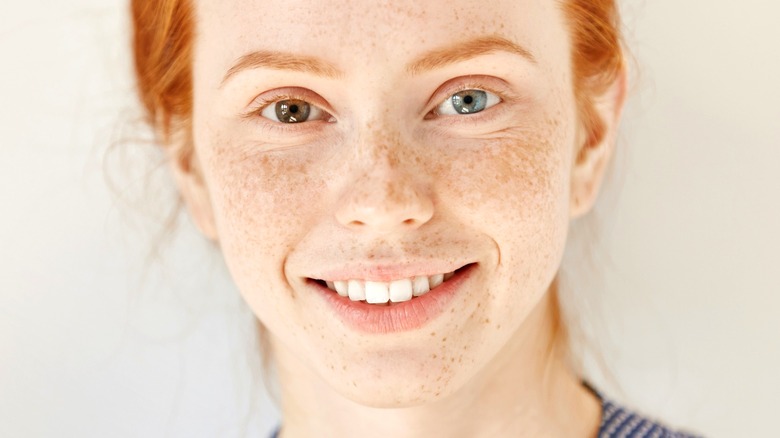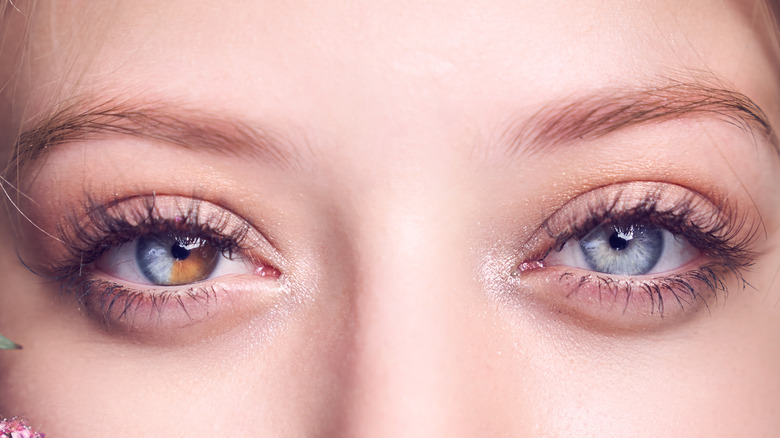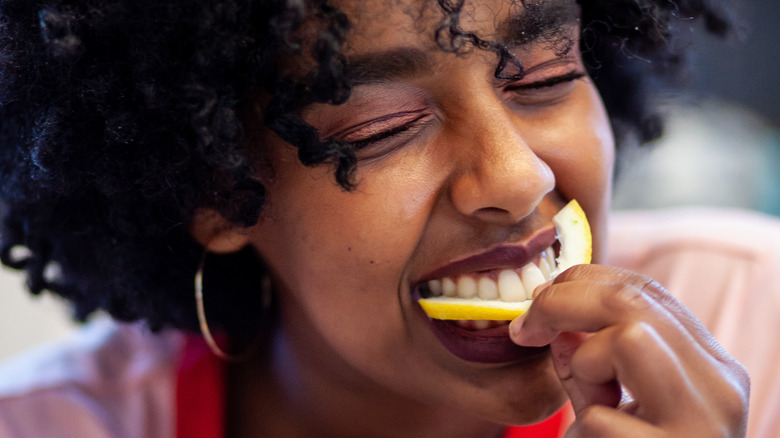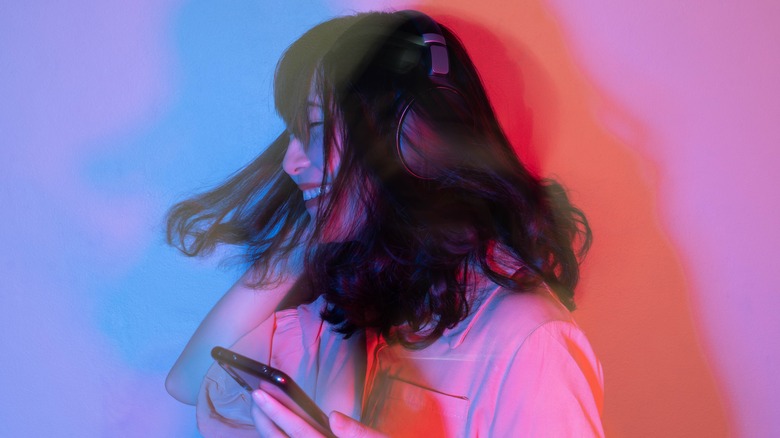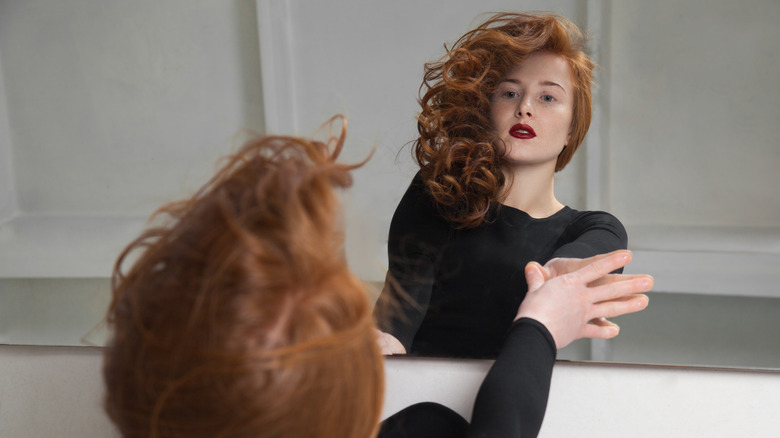The Rarest Body Features, According To Science
The human form is an incredible thing. Not only is it capable of amazing feats — we'll never get over moms hulking out to lift cars off their children — but each person's body is its own unique collection of parts, features, and qualities. We're not just talking about fitting into the Kibbe system's 13 body types, either. Think of all the ways our bodies look and act differently: Everything from ear shape and hairline to flexibility and even perception can vary from person to person. Fortunately, being unconventionally attractive pays off, making your one-of-a-kind appearance both alluring and memorable.
Of course, some looks and traits are still more common than others. So what kind of physical characteristics really stand out? To learn more about the human body's singular range, Glam spoke exclusively to Dr. Raj Dasgupta, quadruple board-certified physician and chief medical advisor for Fortune Recommends Health. Touching on fascinating idiosyncrasies like heterochromia and synesthesia, Dr. Dasgupta walked us through some of humanity's rarest body features and traits.
Multicolored eyes are an unusual but compelling feature
They say that the eyes are the windows to the soul, and society certainly seems to put a lot of stock into admiring their beauty. Certain eye colors are even considered more attractive. But did you know that some people can boast more than one hue in their irises? This is a unique physical quirk known as heterochromia.
"Heterochromia is when a person has two different colored eyes," Dr. Raj Dasgupta tells Glam exclusively. Apparently, this can result from various factors. As the physician goes on, heterochromia can be "caused by genetics, injury, or conditions that affect melanin, the pigment in the iris." Whatever the root, multicolored eyes are a rarity. According to WebMD, only 1% of people across the entire globe have heterochromia — or roughly 82 million people worldwide.
There are a few famous examples of heterochromia among celebrities, such as actors Jane Seymour, who has one green and one brown eye, and Kate Bosworth, who has one blue and one hazel eye. But it's possible for heterochromia to fly under the radar — sometimes, this feature can be difficult to spot if the shades are similar or don't take up the entire iris. That's right, heterochromia can even manifest with multiple colors within the same eye, creating a striking patchwork effect. Examples of this take on heterochromia include "Saved by the Bell" star Elizabeth Berkley, who has one half-brown and half-green eye.
Most people have two nipples — but some people have more
Unlike many other mammals, humans have evolved away from having extensive sets of nipples — after all, we're not usually giving birth to entire litters of kids, and one pair of teats is often enough to get by. But there are still cases where newborns can arrive with a bonus nub or two. "Supernumerary nipples are extra nipples along the chest or abdomen, resulting from leftover tissue from fetal development that looks like moles," Dr. Raj Dasgupta explains exclusively to Glam.
Because of their mole-like appearance, some people may not even realize they have extra nipples. The location is one good clue: These appendages tend to appear along two hidden ridges called milk lines, which run from beneath the armpit down to the groin. Most often, a person will just have one supernumerary nipple, appearing below their regular nipples for a total of three. But occasionally someone could be born with four, five, or even up to eight nipples.
Fortunately, supernumerary nipples are usually harmless and can even be removed. However, there's no reason to feel self-conscious about these unobtrusive features. Supernumerary nipples are estimated to occur in around 6% of the population, according to DermNet, and even stars like Mark Wahlberg and Lily Allen have opened up about their vestigial nipples. So while these extra nubbins are unusual, they aren't totally unheard of, and bearers are in esteemed company.
Having concentrated taste buds can turn you into a rare supertaster
Typically, having multicolored eyes or extra nipples only impacts your appearance. But some rare features can also affect how you experience the world; this includes having more than the average number of taste buds, which can classify you as a "supertaster." As Dr. Raj Dasgupta tells Glam in our exclusive chat, "Being a supertaster means having a stronger sense of taste, due to more taste buds and certain genes that make flavors, like bitter or sweet, more intense."
At first, being a supertaster sounds kind of fun. Who wouldn't want to luxuriate in a deeper flavor from favorite foods? However, this ability can easily backfire. Remember, Dr. Dasgupta pointed out that supertasters are extra receptive to flavors like bitterness, which could ruin the experience of eating foods with bitter undertones — like broccoli, beer, coffee, and even chocolate.
Ultimately, it all comes down to the taste buds. Adult humans usually have between 2,000 and 4,000 taste buds, most of which are located across the tongue. This works out to about 15 to 35 taste buds in each 6-millimeter section. Meanwhile, supertasters can have 35 to 60 taste buds in the same area — roughly double the amount. According to Healthline, up to 25% of the population has enough extra taste buds to qualify as supertasters. So if you know any particularly picky eaters, it might just be a case that their taste receptors are more sensitive. On the flip side, a quarter of the population has fewer than average taste buds, creating "non-tasters" who are probably happy to eat just about anything.
Folks with synesthesia experience the five senses in surprising ways
Many of our features are tied to the five senses — our noses handle smell, our ears take in sound, and our eyes process sight. But sometimes the most unusual body traits aren't so obviously visible. Dr. Raj Dasgupta draws our attention to a rare connection known as synesthesia. As he exclusively tells Glam, "Synesthesia is when one sense triggers another (such as hearing sounds and seeing colors) because of unique brain wiring that connects different senses."
For those of us without synesthesia, the effect can be hard to imagine. What does it really mean to experience extra sensory reactions? Often, this causes unexpected correlations in the brain. For example, someone with synesthesia (also called "synesthetes") might see colors when they hear sounds, experience a specific taste when they see or hear certain words, or hear an imaginary noise after smelling something.
Like being a supertaster, synesthesia sounds a little bit like a superpower. It's no wonder that it's sometimes linked to artistry. Past and present, famous creators with synesthesia reportedly include Billie Eilish, Marilyn Monroe, Kanye West, Nikola Tesla, and even Beyoncé. However, because synesthesia is uncontrollable, it can sometimes be annoying and distracting, such as making it difficult to read smoothly. In either case, it continues to be a relatively rare trait — per Cleveland Clinic, it's believed that at least 4% of people may have synesthesia, though it's hard to track all the possible variants.
Mirror-touch synesthesia takes empathy to the next level
Among all the wild and interesting sub-types of synesthesia, Dr. Raj Dasgupta made a point to mention one particularly unusual variant known as mirror-touch synesthesia. "Mirror-touch synesthesia happens when someone feels a touch on their own body just by seeing another person being touched," he tells us exclusively. Typically, this experience occurs like a reflection — if you see the person across from you being touched on the left shoulder, you might feel it in your own right shoulder — giving the condition its "mirror-touch" name.
Dr. Dasgupta reveals that the basis of mirror-touch synesthesia is "due to extra connections in the brain's mirror neuron system." Interestingly, there may also be a connection between mirror-touch synesthesia and empathy. A 2017 study in Cognitive Neuropsychology found that participants with this neurological feature were more able to detect emotions when shown photographs of facial expressions, suggesting a level of emotional sensitivity that's above the norm.
In contrast to general synesthesia's 4% occurrence, The University of Delaware estimates that mirror-touch synesthesia only appears in 2 out of every 100 people — or 2% of the population. Sometimes, this neural quirk can be an enjoyable experience for synesthetes, such as when feeling second-hand pleasure from seeing someone receive a hug or get a massage. But mirror-touch synesthesia can also be a double-edged sword. Other times, it's so intense and overwhelming that people with mirror-touch become basically housebound in an attempt to avoid stimulation. And as one synesthete confessed on Reddit, "Mirror-touch can really complicate watching movies."
